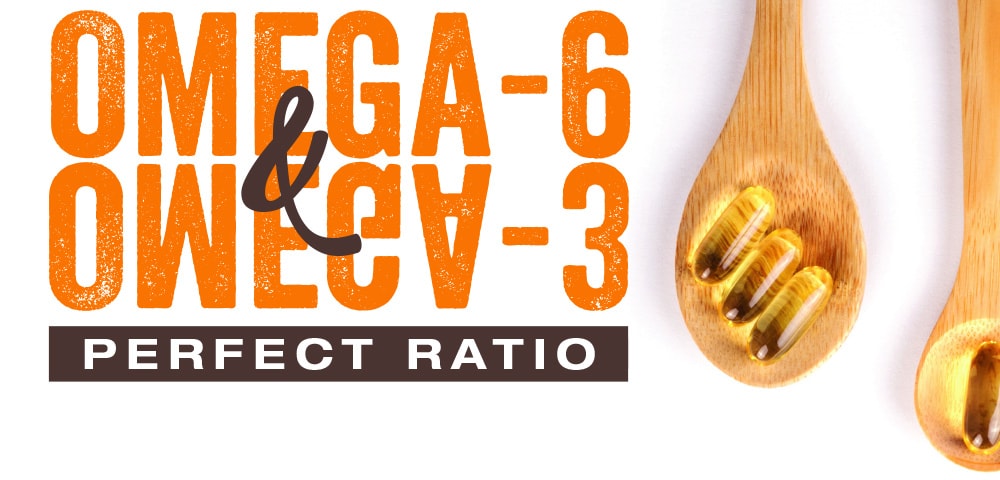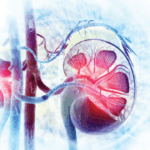
If there was ever a nutrition topic that brought much confusion, it’s the one about fats.
Don’t eat fats, no wait, you need fats!
Eat low fat, no wait, eat full fat!
This ever-changing advice can cause many people to feel perplexed about this key macronutrient. In recent years, there has been much discussion about two important polyunsaturated fats – omega-6 fatty acids and omega-3 fatty acids. Let’s explore the importance of these essential fats for overall health.
Omega-6s and Omega-3s: Finding the Balance
Omega-6 and omega-3 polyunsaturated fatty acids are considered essential. This means the body cannot make these fats on its own, so they must be obtained through our diet and/or from supplements. Many believe human beings evolved on a diet that had a ratio of omega-6 to omega-3 of around 1:1. However, current Western diets appear to deliver a ratio of omega-6 to omega-3 of 10:1 to 20:1 or higher, an indication that our intake of omega-6 fats has dramatically increased over the years. Why is this of concern?
High consumption of omega-6 fatty acids, commonly found in soybeans, corn, safflower oil, and sunflower oil, increases inflammation and may be linked to medical concerns such as cardiovascular disease, arthritis, and obesity.
On the other hand, the omega-3 fatty acids that we consume through fish and fish oil supplements, nuts and seeds, and some plant oils, are known to decrease inflammation.
Therefore, it is important to decrease our consumption of omega-6 fatty acids, especially from processed oils and foods, but we do not need to completely eliminate these essential fats from our diet. Our goal should be balancing our intake of omega-6 and omega-3 fats, aiming for a ratio ranging from 1:1 to 4:1. In addition to increasing omega-3 fats, we can also choose beneficial omega-6 plant seed oils that have several health benefits.
Be Healthy With Gamma-Linolenic Acid (GLA)
Evening primrose oil, borage oil, hemp seed oil, and black currant seed oil provide a high abundance of GLA, a beneficial omega-6 polyunsaturated oil with positive health effects. GLA is also produced when we metabolize linolenic acid (LA), however this process may be restricted by factors such as stress, smoking, and deficiencies of nutrients such as magnesium, vitamin B6, and zinc. We can bypass this by supplementing directly with GLA from the sources listed above.
When we consume GLA it is metabolized to DGLA (dihomo-gamma-linolenic acid), which is stored in our cells until needed. When cells are activated, DGLA is converted into metabolites that possess anti-inflammatory and immunoregulatory properties, among other benefits. These actions outline the importance of GLA in supporting conditions such as skin concerns, arthritis, asthma, and diabetic neuropathy.
Glowing Skin
Deficiencies of essential fatty acids, including GLA, can lead to skin concerns such as dryness, peeling, irritation, and slower healing. In fact, individuals with atopic dermatitis (eczema) reportedly have low blood levels of GLA and DGLA, and metabolites of GLA may help reduce inflammation, as well as increase ceramide production and improve skin barrier function.
More research is needed in this area; however in one pilot study, supplementation with evening primrose oil (4–6 g providing 320–480 mg of GLA daily) for 12 weeks resulted in a significant increase of blood GLA and DGLA levels, along with a decrease in the SCORing atopic dermatitis index, indicating a decrease in symptoms such as redness, dryness, and swelling. Whereas 42.9% of patients had mild symptoms and 57.1% had moderate symptoms, after the 12-week treatment, 93.2% of patients had mild symptoms and 6.8% had moderate symptoms.
Additional research has supported GLA’s beneficial effects on transepidermal water loss (TEWL), that is the amount of water that passively evaporates through the skin to the external environment. GLA may also help reduce acne severity, with one study showing 400 mg of GLA decreasing inflammatory and non-inflammatory acne lesions.
Improving Arthritis
Research has investigated the benefits of GLA for cases of rheumatoid arthritis and has found significant improvements in pain and global function. An 18-month randomized, double-blind, comparison trial looked at the use of borage seed oil (1.8 g of GLA), fish oil (2.1 g of EPA and 1.4 g of DHA), and a combination of both oils in patients with rheumatoid arthritis. All three treatment groups experienced significant reductions in disease activity scores as well as the clinical disease activity index, indicating the benefits of GLA for rheumatoid arthritis. Patients in this study were also able to reduce their need for disease-modifying antirheumatic drugs (DMARDs) commonly used to treat rheumatoid arthritis.
Supplementing with GLA
Green leafy vegetables and nuts provide small amounts of preformed GLA; however human milk and supplemental sources, such as borage oil (18–26% of GLA), black currant oil (15–20% of GLA), and evening primrose oil (7–10% of GLA), provide more significant amounts. GLA is generally well tolerated and appears to be safe when taken in doses up to 2.8 g per day or less for up to one year. Some people may experience side effects such as loose stools, gas, and headaches when using GLA. Since GLA may have anticoagulant effects, it’s important to speak to your health professional if you are using blood-thinning medications.
Can you supplement with GLA and EPA/DHA from fish oil? Absolutely! Don’t forget that we must balance our intake of good fats. These key omega-6 and omega-3 fatty acids complement one another and can be used successfully together to manage inflammation and support overall health.
| Test Your GLA IQ! | ||||
|---|---|---|---|---|
| It’s important to avoid all types of omega-6 fatty acids. | GLA is a type of: |
Important supplemental sources of GLA include: | Balancing omega-6 fatty acids and omega-3 fatty acids is important for overall health. | GLA may be helpful for: |
| A. True B. False |
A. Saturated fat B. Omega-3 fatty acid C. Omega-6 fatty acid D. Monounsaturated fat |
A. Borage oil B. Black currant oil C. Evening primrose oil D. All of the above |
A. True B. False |
A. Skin health B. Rheumatoid arthritis C. Diabetic neuropathy D. All of the above |
| Answer: B | Answer: C | Answer: D | Answer: A | Answer: D |
| Test Your GLA IQ! | ||||
|---|---|---|---|---|
| It’s important to avoid all types of omega-6 fatty acids. | ||||
| A. True B. False |
||||
| Answer: B | ||||
GLA is a type of: |
||||
| Saturated fat Omega-3 fatty acid Omega-6 fatty acid Monounsaturated fat |
||||
| Answer: C | ||||
| Important supplemental sources of GLA include: | ||||
| A. Borage oil B. Black currant oil C. Evening primrose oil D. All of the above |
||||
| Answer: D | ||||
| Balancing omega-6 fatty acids and omega-3 fatty acids is important for overall health. | ||||
| A. True B. False |
||||
| Answer: A | ||||
| GLA may be helpful for: | ||||
| A. Skin health B. Rheumatoid arthritis C. Diabetic neuropathy D. All of the above |
||||
| Answer: D | ||||
References
- D’Angelo S, Motti ML, Meccariello R. ω-3 and ω-6 polyunsaturated fatty acids, obesity and cancer. Nutrients. 2020; 12(9):2751.
- Patterson E, Wall R, Fitzgerald GF, et al. Health implications of high dietary omega-6 polyunsaturated fatty acids. J Nutr Metab. 2012; 2012:539426.
- Gamma-linolenic acid (GLA). Monograph. Altern Med Rev. 2004; 9(1):70-8.
- Sergeant S, Rahbar E, Chilton FH. Gamma-linolenic acid, dihommo-gamma linolenic, eicosanoids and inflammatory processes. Eur J Pharmacol. 2016; 785:77-86.
- Michalak M, Pierzak M, Kręcisz B, et al. Bioactive Compounds for skin health: A review. Nutrients. 2021; 13(1):203.
- Simon D, Eng PA, Borelli S, et al. Gamma-linolenic acid levels correlate with clinical efficacy of evening primrose oil in patients with atopic dermatitis. Adv Ther. 2014; 31(2):180-8.
- Parke MA, Perez-Sanchez A, Zamil DH, Katta R. Diet and Skin Barrier: The role of dietary interventions on skin barrier function. Dermatol Pract Concept. 2021; 11(1):e2021132.
- Jung JY, Kwon HH, Hong JS, et al. Effect of dietary supplementation with omega-3 fatty acid and gamma-linolenic acid on acne vulgaris: a randomised, double-blind, controlled trial. Acta Derm Venereol. 2014; 94(5):521-5.
- Cameron M, Gagnier JJ, Chrubasik S. Herbal therapy for treating rheumatoid arthritis. Cochrane Database Syst Rev. 2011; (2):CD002948.
- Reed GW, Leung K, Rossetti RG, et al. Treatment of rheumatoid arthritis with marine and botanical oils: an 18-month, randomized, and double-blind trial. Evid Based Complement Alternat Med. 2014; 2014:857456.
- Dobryniewski J, Szajda SD, Waszkiewicz N, Zwierz K. Kwas gamma-linolenowy (GLA)–znaczenie terapeutyczne [The gamma-linolenic acid (GLA)–the therapeutic value]. Przegl Lek. 2007; 64(2):100-2. Polish.
- Aragona P, Bucolo C, Spinella R, et al. Systemic omega-6 essential fatty acid treatment and pge1 tear content in Sjögren’s syndrome patients. Invest Ophthalmol Vis Sci. 2005; 46(12):4474-9.
- Schirmer MA, Phinney SD. Gamma-linolenate reduces weight regain in formerly obese humans. J Nutr. 2007; 137(6):1430-5.
- Fan YY, Chapkin RS. Importance of dietary gamma-linolenic acid in human health and nutrition. J Nutr. 1998; 128(9):1411-4.












